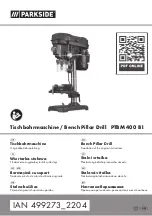
5
ENGLISH
(Original instructions)
c.
When battery pack is not in use, keep it away from
other metal objects, like paper clips, coins, keys,
nails, screws, or other small metal objects, that can
make a connection from one terminal to another.
Shorting the battery terminals together may cause burnsor
a fire.
d.
Under abusive conditions, liquid may be ejected from
the battery; avoid contact. If contact accidentally
occurs, flush with water. If liquid contacts eyes,
additionally seek medical help. Liquid ejected from the
battery may cause irritation or burns.
e.
Do not use a battery pack or tool that is damaged or
modified. Damaged or modified batteries may exhibit
unpredictable behaviour resulting in fire, explosion or risk
of injury.
f.
Do not expose a battery pack or tool to fire or
excessive temperature. Exposure to fire or temperature
above 130 °C may cause explosion.
g.
Follow all charging instructions and do not charge the
battery pack or tool outside the temperature range
specified in the instructions. Charging improperly or at
temperatures outside the specified range may damage the
battery and increase the risk of fire.
6.
Service
a.
Have your power tool serviced by a qualified repair
person using only identical replacement parts. This
will ensure that the safety of the power tool
is maintained.
b.
Never service damaged BATTERY packs. Service of
BATTERY packs should only be performed by the
manufacturer or authorized service providers.
Additional power tool safety warnings
@
Warning!
Additional safety warnings for screw-
drivers.
●
Hold power tool by insulated gripping surfaces, when
performing an operation where the Fasteners may
contact hidden wiring. Fasteners contacting a "live"
wire may make exposed metal parts of the power tool
"live" and could give the operator an electric shock.
●
Wear ear protectors with impact wrenches. Exposure
to noise can cause hearing loss.
●
Use auxiliary handles supplied with the tool. Loss of
control can cause personal injury.
●
Use clamps or another practical way to secure and
support the work piece to a stable platform. Holding
the work by hand or against your body leaves it unstable
and may lead to loss of control.
●
Before driving fasteners into walls, floors or ceilings,
check for the location of wiring and pipes.
●
The intended use is described in this instruction
manual.
●
The use of any accessory or attachment or
performance of any operation with this tool other than
those recommended in this instruction manual may
present a risk of personal injury and/or damage to
property.
Safety of others
● This tool is not intended for use by persons (including
children) with reduced physical, sensory or mental
capabilities, or lack of experience and knowledge,
unless they have been given supervision or instruction
concerning use of the appliance by a person responsible
for their safety.
● Children should be supervised to ensure that they do not
play with the appliance.
Residual risks
Additional residual risks may arise when using the tool which
may not be included in the enclosed safety warnings. These
risks can arise from misuse, prolonged use etc.
Even with the application of the relevant safety regulations
and the implementation of safety devices, certain residual
risks can not be avoided. These include:
● Injuries caused by touching any rotating/moving parts.
● Injuries caused when changing any parts, blades
or accessories.
● Injuries caused by prolonged use of a tool. When using
any tool for prolonged periods ensure you take regular
breaks.
● Impairment of hearing.
● Health hazards caused by breathing dust developed when
using your tool (example:- working with wood, especially
oak, beech and MDF.)
Vibration
The declared vibration emission values stated in the technical
data and the declaration of conformity have been measured in
accordance with a standard test method provided by
EN62841
and may be used for comparing one tool with another.
The declared vibration emission value may also be used in a
preliminary assessment of exposure.
@
Warning!
The vibration emission value during actual
use of the power tool can differ from the declared
value depending on the ways in which the tool is
used. The vibration level may increase above the
level stated.
When assessing vibration exposure to determine safety
measures required by 2002/44/EC to protect persons regularly
using power tools in employment, an estimation of vibration
exposure should consider, the actual conditions of use and the
way the tool is used, including taking account of all parts of the
operating cycle such as the times when the tool is switched off
and when it is running idle in addition to the trigger time.






























